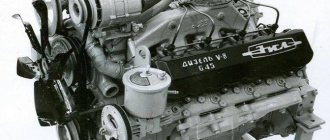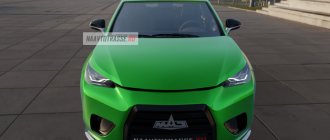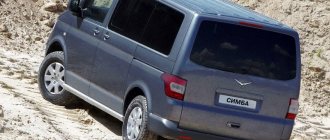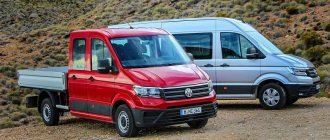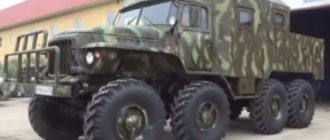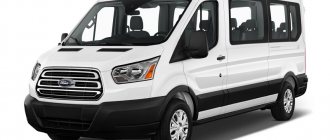The enterprise, which later transformed into the Likhachev plant, appeared during the times of the Russian Empire. Over time, trucks began to be assembled here, which were also supplied to military units. Until the mid-1970s, ZIL met the needs of the Soviet economy for vehicles of this type. However, at that time the country’s economy required the supply of trucks in larger quantities, which is why it was decided to build another automobile plant on the territory of modern Tatarstan. This led to the emergence of KamAZ, to which the Soviet leadership sent all the best engineers.
The emergence of a new automobile plant largely predetermined the fate of ZIL. Already in the 1980s, the company found itself in a serious design crisis: it did not have engineers capable of creating new vehicles that could compete with KamAZ. In the 1990s and especially in the 2000s, the Moscow government stepped up efforts to attract new partners with the help of which the restoration of ZIL was planned. During that period, several contracts were concluded with investors and the production of foreign (including Chinese) trucks was established. But, as it became clear later, each partnership was temporary. As a result, the company was officially declared bankrupt by 2015, and 5 years later the car plant was completely demolished.
However, it recently became known that an American entrepreneur of Russian origin bought the ZIL brand and announced his plans to produce new SUVs under this brand, which will be supplied to the US army. To date, no precise information about future new products has been received from the developers. The only thing that is known is that all SUVs will be built on the Jeep platform using powerful Chrysler engines.
The news of the return of the ZIL brand to the market made independent designers think about what the model range of the now former Russian company could become if the new owner does not limit himself to only military vehicles. One of the new products may be the compact crossover ZIL-130 2021-2022, which will compete with the Hyundai Creta or Kia Seltos. An independent designer recreated the look of such a model by publishing a series of renderings.
Design
The presented crossover of the ZIL brand is designed in the style of many modern budget-class SUVs. Externally, the model, in particular, is similar to its direct competitors - Hyundai Creta and Kia Seltos. The similarity with Korean crossovers can be seen in the outlines of the body, characterized by sharp transitions and smooth edges. However, despite the above, the Russian-American new product has a unique design that sets it apart from other compact SUVs.
The presented crossover ZIL-131 2021-2022 is, first of all, distinguished by the A-pillars that are heavily tilted back, which turn into an almost flat roof line. The latter is located at a subtle slope in relation to the stern. The compact rear pillars of the ZIL crossover are designed, apparently, with an eye on the Kia Seltos. Under them there is a fold, which not only visually increases the dimensions of the rear part of the body, but also makes the wheel fenders more voluminous.
The smooth hood of the presented new product is framed at the edges by rounded folds, which emphasize the youth design of the SUV. Moreover, as they move towards the front, they seem to go into the body. The edge of the hood in the area of the radiator grille smoothly bends downwards. This design decision, combined with the heavily flared pillars, is likely to have a positive effect on the car's aerodynamic performance.
From full-fledged SUVs, the new ZIL crossover has been replaced by a large rectangular radiator grille, repeating the smooth curve of the front part of the body. It contains several horizontal wide lamellas with cutouts for airflow into the engine compartment. An interesting detail of the front part of the body is the large head optics with two sections of LED lights, above which lie LED DRL strips.
The second notable detail is that the front bumper is visually divided into 3 parts. The central one, as noted earlier, is given over to a large radiator grille, and the two side ones, going deep into the body, contain raised niches for black plastic inserts containing round fog lights. The image of the front part of the body is completed by a protrusion on the front bumper, simulating a splitter.
The Russian new product was equipped with large rims, which is why the developer had to expand the side arches. Along the bottom of the side doors and fenders there is a thin strip of plastic body kit, painted in a contrasting black color. As in the case of the Kia Seltos, the new ZIL crossover has very compact rear windows due to the rising window sill line, which will negatively affect visibility from the cabin.
The food of the presented crossover ZIL-130 2021-2022 is designed in a sporty style. This feature is emphasized by the heavily covered rear window, above which there is a compact wing with an additional brake light. The previously mentioned protrusion, which is located under the support struts, smoothly moves to the stern, forming here a kind of spoiler. Narrow lights with LED strips in the center are attached to it.
The rest of the stern of the presented new product runs almost vertically in relation to the road surface. But because of this protrusion, there is a feeling that the rear part of the body has three-dimensional shapes. The rear bumper recedes noticeably from the body, which is more typical for SUVs than for compact crossovers. The body kit, made of black plastic, contains 2 wide exhaust pipes. This feature indirectly indicates the presence of a powerful engine under the hood of the car. But given how the presented crossover is positioned, most likely one of the pipes is an imitation.
Zil 130 history of the car
Designers began to think about replacing the base model of the truck. To partially solve the problems, a modernized version of the “150” was created - “ZIL-164”, but not only the “ ZIL-164 ”, but even the improved “ ZIL-164A . new car was needed . After the further development of the “165” model was recognized as inappropriate, in 1958 at the All-Russian Agricultural Exhibition a new version of vehicle , which received the index ZIL-131 and a cabin with a “tail” from the civilian (experienced at that time) ZIL-130 . However, the military was not satisfied with the complex bent front fenders and the complex shape of the radiator lining, since returning them to their original shape in the field would require a significant amount of time, so ZIL-131 car , put into mass production, received simple bent front fenders and the same simple-minded radiator lining . In 1953, ZIS began working on a prototype of the new basic truck " ZIS-125 " (according to the design documentation - "ZIS-150M"). It was she who became the prototype of the 130, which was born ten years before the ZIL-130 became widespread. “ ZIS-125 ” was constantly improved, and in 1956 a new version was assembled with a different appearance and under the symbol “ ZIL-130 ”.
A lot of work was done to organize the production of the ZIL-130 truck. Suffice it to say that about 3,600 pieces of molds alone were produced. And this is not counting 10 thousand different devices, more than 37 thousand items of various specialized tools. The production of ZIL-130 cars and V-engines led related industries to the need to develop high-octane fuel, new types of motor oils, working fluids, as well as fundamentally new paints and upholstery materials, high-quality rubber products and plastics. The design and production technology of the “130go” brought a number of priorities to the USSR automotive industry. With car , the following came to the domestic auto industry: power steering, a synchronized gearbox with constant-mesh helical gears, a new design of driveline joints, a three-seater cabin (previous cabs were double), a windshield washing system, an engine pre-heater and much more. other.
In 1959, factory tests of new
trucks , then acceptance tests, and in 1961-1962. the plant was supposed to switch to production ZIL-130 and ZIL-131 cars . The first 5 pre-production ZIL ov-130 were manufactured in 1962. For trial operation they were transferred to the Yaroslavl Tire Cars and began rolling off the assembly line in 1963, but mass production began only on October 1, 1964, when the general reconstruction of the plant was completely completed. The exterior design was beautiful for a truck of that time: panoramic windshields, a hood, streamlined fenders with smooth contours and an expressive light gray or white radiator grille. Having “recovered” from the main “childhood diseases”, which included frequent failures of electrical equipment, weak driveshaft joints, etc., “ZIL-130” received a state quality mark and gained good export potential. It was sold to more than forty countries around the world, the “third world”, of course. At the request of the customer, the car was equipped with an economical English Perkins , developing 140 hp. Time passed, and the car, no matter how successful it was, needed modernization. In 1972, a number of changes were made to its design, which made it possible to increase the load capacity from 5 to 6 tons. Later, in accordance with the requirements of the standard for the location of external lighting devices, the radiator lining was changed. ZIL-130-76 in 1976 . In 1974, the millionth ZIL-130 was assembled on the main assembly line. The next modernization also left a mark on the model index. It became known as “ ZIL-130-80 ”. After the next innovations in 1986, the car was given a new designation, in accordance with the industry-standard indexing system, “Z IL-431410 ”. Despite all the tricks during several modernizations, the original design of the ZIL-130 no longer met the requirements of the time, especially since in 1986 ZIL began producing more advanced diesel vehicles ZIL-4331. On September 16, 1992, ZIL-130 began to be produced at a ZIL branch - the Ural Automotive Plant (UAMZ) in the city of Novouralsk. True, these vehicles were a simplified version of the ZIL-431410 with a tail unit unified with the ZIL -131N vehicle . And in Moscow, the last representative of the “one hundred and thirty” family with serial number 3,388,312 rolled off the assembly line of AMO “ZIL” on December 30, 1994. Since 1986, in accordance with OST 37.001-269-83, cars of the ZIL-130 family received new indices: ZIL-431410 (ZIL-130), ZIL-431510 (ZIL-130G), ZIL-441510 (ZIL-130V1), ZIL- 431810 (ZIL-138), ZIL-431610 ( ZIL-138A ) and others ZIL-130 became the first truck of the ZIL brand, which was regularly painted in civilian colors (white and blue). Before this, all Zilov trucks were painted khaki for military use. Since 1989, the Mytishchi Machine-Building Plant has produced on their basis the ZIL-MMZ-4510 dump truck, equipped with a metal platform with a dumping mechanism, unified in many elements with the ZIL-MMZ-4505 .
car has been produced by the Likhachev Moscow Automobile Plant since 1966. until 1986. The body is a military-type wooden platform with a folding rear side, folding benches for 16 seats are built into the side side bars, there is a middle removable bench for 8 seats, installation of arches and an awning is provided. The main trailer is SMZ-8325 (military). The following main versions of the vehicle were produced: onboard (with and without a winch), a vehicle with unshielded electrical equipment ZIL-131A , a truck tractor ZIL-131V , a chassis for mounting various special equipment. Since 1986, a modernized version of the ZIL-131N has been produced. Production of ZIL-131N directly by ZIL was curtailed in 1994 in connection with the start of production of ZIL-4334, but at UAMZ, which traditionally produces cars , production of ZIL-131N continues.
During the entire production period, the appearance of the ZIL-131 practically did not change.
Engine
Under the hood of the ZIL-130, an experimental carburetor V6 with a displacement of 5.2 liters and a power of 135 hp was installed. The very next year, experimental ZIL-130s appeared with a modified cabin and tail. They were equipped with overhead valve ZIL-120 engines with six cylinders arranged in a row (5555 cc, 140 hp). However, these power units did not take root; in 1958 they were replaced by a more advanced V8 with a 90° cylinder block. This was the famous ZIL-130 engine (5966 cc, 150 hp), unified with the ZIL-375 engine, intended for city buses and three-axle Ural trucks.
Modifications of Zil 130:
ZIL-130 Prototype 1958 ZIL-130 Prototype 1962 ZIL-130-66 - modification of 1966. ZIL-130-76 - modification of 1976. ZIL-130-80 - modification of 1980. ZIL-130-80GU ZIL-130 A ZIL-130 AN ZIL-130 ANSH ZIL-130 B ZIL-130 B2 ZIL-130 B2SH ZIL-130 B2-76 ZIL-130 V ZIL-130 V1 (1962-1994) - tractor ZIL-130 V1-76 ZIL-130 G - with an extended base (4500 mm) ZIL-130 G1 ZIL-130 G1-76 ZIL-130 GU - with a particularly long base (5000 mm), produced in separate batches since 1977. ZIL-130 GU-76 ZIL-130 D ZIL-130 D1 ZIL-130 D1SH ZIL-130 D2 ZIL-130 E ZIL-130 K ZIL-130 KSH ZIL-130 N ZIL-130 S - northern version of the ZIL-130 S- 76 ZIL-130 Sh ZIL-MMZ 130S ZIL-MMZ 130P ZIL-138 A - gas-cylinder version of the tractor.
Today, the Urals offer consumers cars the AMUR-53131 family , which are based on the ZIL-130 design. Outdated, but reliable and easy to use, and also affordable, the truck is still in demand. The mentioned model is still equipped with a cabin and empennage from the veteran ZIL-131 or modern and more comfortable analogues borrowed from the truck .
AMUR-53131 with a payload of 6 tons is equipped with various types of engines. Among them is the gasoline engine AMUR-456.10 (aka ZIL-508.10) with a power of 150 hp, the alternative to which is a diesel engine - the 108-horsepower D-245.12 of the Minsk Motor Plant. The cars are also equipped with their own V-shaped 8-cylinder units AMUR-0555 (7.6 l) and AMUR-5551 (6.28 l) with a power of 145 and 180 hp, respectively. In 2006, the AMUR-53131M modification was equipped with a 136-horsepower D-245.9E2 diesel engine that meets Euro 2 environmental standards.
It is important that when placing the engines, they do not require modification of the seats. The power plants are coupled with a manual 5-speed gearbox. The listed models are a suitable transport base for the installation of various special equipment. In addition to the onboard vehicle, designed for operation at temperatures from +55 to –45 °C, the model range includes construction and agricultural dump trucks, vacuum vehicles , fuel tankers and tank trucks for transporting fuel and food liquids, hydraulic lift trucks, concrete mixer trucks, fire fighting equipment, and various municipal vehicles. types, etc.
And in Moscow, for several years, they have been producing a direct descendant of the “130”, which, after being equipped with a more modern and comfortable cabin from the diesel ZIL-4331, received the designation ZIL-433360. Along with the onboard vehicle, the ZIL-433362 chassis is manufactured, intended for the installation of special bodies and various superstructures. Those who do not want to put up with the gluttony of the gasoline ZIL-508.10 can order a truck with the mentioned D-245.9 diesel engine. In this case, the model bears the index ZIL-4329/
More information about military equipment can be found on the Documentary Films website
Specifications
The technical part of the presented crossover raises questions. The fact is that the developer who published the render images did not say anything about the possible motor range. However, if we consider that the first ZIL SUV will be created on the basis of the Jeep platform, then we can assume that the presented model will borrow the “trolley” from the Compass crossover. This means that both cars will share the engine range.
In this case, the ZIL-131 2021-2022 crossover may receive a basic 2-liter “aspirated” engine that develops up to 150 hp. power. Optionally, the presented new product will be equipped with another naturally aspirated 2.5-liter unit, developing up to 175 hp. Each of the engines is combined with a 9-speed automatic transmission and proprietary all-wheel drive, capable of transmitting up to 100% of the traction torque to any wheel. Also, both engines are equipped with a system that adapts the transmission to current road conditions.
The history of the creation of the ZIL "Kolkhoznik"
ZIL MMZ 554 trucks begin their history in 1953. It was this year that the famous car rolled off the factory assembly line. And instantly won a leading position in the truck niche.
The release of this car affected the life of almost every region of our country. A similar machine appeared in every city, town or collective farm. In one modification or another.
Every year the model range expanded and improved. The most popular was the ZIL MMZ-554-M. Better known as "Collective Farmer". This modification had a dump body type, with dimensions suitable for many jobs.
ZIL Kolkhoznik - dump truck, photo MMZ-544-M with side unloading
The first models, which are known to many in this form, began to be produced in 1964. This model was based on the ZIL-130 prototype. It was originally conceived as a multifunctional platform for many modifications.
On the basis of this model, vehicles were created for the agricultural, military, and construction industries. With a variety of platforms in each of them. For example, urban modifications of garbage trucks or fire trucks. Or trucks for transporting grain or water.
Additional characteristics and modifications
The brakes are of the shoe-drum type; operate using pneumatics. To operate the braking system, a compressor is used that fills the corresponding cylinder with compressed oxygen - the efficiency at 2 thousand revolutions is 220 l/m. The truck's electrical power comes from a battery. Voltage - 12 V; current - 90 A/h. Tire size (tires) - 260-508(P) R20.
For the automotive industry of the USSR, a fairly advanced steering system was used: a hydraulic booster with a double vane pump rotating from the crankshaft via a belt was then considered an innovative solution. To find out how much the ZIL-130 weighs, you need to determine the name of the specific model. The weight of the standard version is 4300 kg.
5 modifications of the car were developed:
- 130A - onboard tractor;
- 130B - dump truck, widely used in agricultural work;
- 130V - truck tractor;
- 130G - extended flatbed truck with a platform;
- 130W - with a reinforced rear axle, a distinctive feature.
ZIL 130 fuel consumption per 100 KM
For its time, the basic ZIL-130 was a fairly powerful car, and the fact that the ZIL 130 has such high fuel consumption per 100 km is due to this. The car has an engine equipped with 8 cylinders. All modifications of this model have power steering, as well as a 5-speed gearbox. It uses A-76 fuel for movement.
| Engine | Consumption (highway) | Consumption (city) | Consumption (mixed cycle) |
| ZIL 130 | 25 l/100 km | 35 l/100 km | 30 l/100 km |
ZIL-130: history
Before entering public roads, the ZIL-130 has come a long way from development and testing to the release of the first pilot batch. The first steps towards creating a car were taken in 1957. It took Soviet engineers five years and titanic efforts to match the car's power with its performance characteristics and select a suitable power unit.
The first experimental batch of ZIL-130 rolled off the manufacturer's assembly line in 1962. Cars received user recognition only in 1963. Finally, in 1964, mass production of cars began. The production of ZIL-130 continued until 2010 at the Ural Automotive Plant.
Body volume ZIL-130 dump truck
- tipper platform area - 8.7 m2;
- dumping platform volume - 5 m3;
- volume with extension sides - 7.8 m3;
- platform elevation angle - 50 degrees;
- unloading direction - back, right, left;
- platform dimensions - 2325x3752 mm.
Get an advantageous offer from direct suppliers:
Zil-130 first rolled off the production line in the 60s. Plant named after Stalin managed to produce a car with a synchronized gearbox, equipped with power steering. The new dump truck not only met expectations, but also exceeded them: a glass washer, a heated engine, a three-seater cab - all this was new. The Zil-130, whose technical characteristics were aimed at maximizing efficient operation, turned out to be so successful that it is still in production today. Only the name has changed - now it is “AMUR 53131”. What is special about this model and why did this truck become one of the most powerful in the Soviet Union? In this article we will look at this issue.
